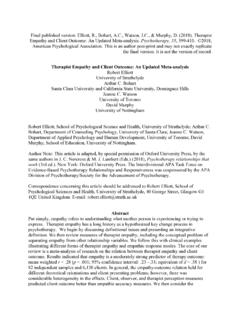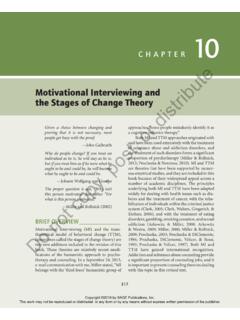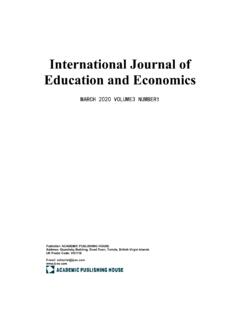Transcription of 1: Overview of Self-Determination Theory: Organismic ...
1 1: Overview of Self-Determination theory : An Organismic Dialectical Perspective Richard M. Ryan Edward L. Deci Unwersity o/ Rochestu In the classical, Aristotelian, view of human development, people arc assumed to possess an active tendency toward psychological growth and integration. Endowed with an innate stT h~ng to exercise and elaborate their interests, indi-viduals tt:nd naturally to seck challenges, to discover new perspectives, and 10 actively internalize and transform cultural practices. By stretching capaci-ties and expressing talents and propensities, people actualize their human potentials.
2 Within this perspective, active growth is complemented by a tendency toward synthesis, organization, or relative unity of both knowledge and person-ality. Moreover, the integration of that which is experienced providt-s the basis for a coherent sense of self -a sense of wholeness, vitalit}\ and integrity. To the degree that individuals have attained a sense of self , they can act in accord "~th, or be "true" to, that seU: This general view of an active, integrating organism with the potential to from a coherent sense of self can be found in psychodynamic and humanistic theories of personality and in cognitive theories of development.
3 For example, psychoanalytic theorists posit inherent activity and a synthetic function of the ego (Freud, 1927; Nun berg, 1931; Meissner, 1981; White, 1963), and humani.~tic psy-clJOlogists postulate an actualizing tendency (Angyal, 1963; Maslow, 1955; Rogers, 1963). Similarly, many cognitive d<:vclopmcntal theories emphasize an organizational or imcgrativc tendency as an endogenous feature of the organism, proposing that development is clmracterized by an overarching organization function through which new self -extensions are brought into coherence with other cognitive stmctures (Piagct, 1971; 'vVerncr, 1948).
4 Preparation of this chapter was supported in part by a n:st~ gram from the National Institute of Mental Health (MH-53385). Copyrighted materia 4 HA '\l)BOOK OF ::TERMlKA'l'lOK lo Vat] ing degrees, some recent theories have continued 10 embrace s uch ao;sumptions ( ,, Ford, 1992; Locvinger & Blasi, 1991; Kuhl & Fuhrmann, 1998), recognizing the intrinsic propensities of people to engage active, curios-ity-based exploration and to integrate new experiences to the self . Oc~pite its lo ngevity and seeming popularity, the assumption of innate ten-dencies toward growth and integration is not without its critics.
5 Among the more staundl oppom:nts of constructs concerning growth and integration have been operant be haviorists who assume there is no inherent direction to development and suggrs t that beha.,.;oral regulation and personality arc a function of rein-forcement histories and current contingencies ( , Skinner, 1953). For them, any appearance of a n inner organization to personality is attributable not to a pre-sumed integrative tendent:y but rather ro the fact that the relevant contingencies people encountered in their environmems were organized and systematic.
6 Similar!)\ contemporary social-cog nitive approaclu;s portray personality not in tcmts of a sell~unifying system, but rather as a collection of selves or that arc activated by cues. Personality is viewed as a repository for schemata related to various goals and identities, each of which can be elicited by features of the social contexts (Bandura, 1989; Higgin~, 198i; Markus & Nurius, 1986; Mischel & Shoda, 1995). Unlike their operant predecessors, s theories do not deny the idea of a synthetic tendency in d evelopment, but instead periphcralizc it, focusing on the uni1k'CI properties within isolated gnat schemata or regulatory structures rather than among such schemata or structures.
7 Finally, and perhaps most importantly, the concept of endogenous tcnden-cit"-~ toward psychological growth and unity in development seems to Oy in the face of everyday behavioral observations. Ambient e~;dence could readily sup-port the \~cw that people arc no more characterized by tendencies toward growth and integrity than by propensities to be controlled, fragmemcd, and stagnated in development. Everywhere, we S(:C signs of divided functioning, of inner conOict and a lack of concern \\~th responsibility and community. These widespread symptoms arc echoed psychological theories ( , Broughton, 1987; Greenwald, I 982).)
8 Ln fact, Gergen ( I 993) ~;ewed tl1c metaphor of a core or true self that grows and struggles for unity as a post-romantic view that should be replaced by the acceptance of a postmodern perspective in which the self is more aptly described as fragmented, saturated, and diversely populated by identities that arc imputed by the social world. It s<,em.~ indeed that the field of psychology is quite widdy divided on the issues o f inherent tendencies toward psychologic-ill growth, a unified self ; and autonomous, responsible bcha\~Or. Whereas some theorists sec our nature as including a self -organizing, growth promoting tendency, others see us as wholly lacking such an endowment, and thus as mere conditioned or reactive reflections of our surroundings.
9 Importantly, each position seems to have some prima facie C\~dcncc in i~~ favor. This set of issu"s concerning the degree to which there are inherent tenden-cies toward growt11 and integration is important not only theoretically, but also Copyr ghlcd materia Overview of Se{f- determination Theor_y 5 practically. Insofar as practitioners believe people have a natural tendency toward ' ' ' d h 1 h 1 u gammg mtegnty an en ancmg t 1c1r uman potcnwus, t 1cy WI oncnt 10 sup-porting and facilitating that endogenous tendency across a variety of settings, including homes, schools, work organizations, and therapy clinics.}
10 In contrast, insofar as practitioners assume no such inner tendency toward growth, self -con-struction, and inner coherence, then , d1erapeutic, and other practi-cal intervention srrategies will focus on exogenous means of training, shaping, conrrolling, and directing behavior towards ends deemed to be of The Organismic Dialectic: An Integrating Perspective The primary agenda of self -determinmjon th eo y (SOT; Occi & Ryan, 1985b; Ryan & Deci, 2000b) has been to provide an account of the seemingly discrepant viewpoints characterized, on the one hand, by the humanistk, psy-choanalytic, and developmental theories that employ an Organismic metatheory and, on the other hand, by the beha\~oral, cognitive, and post-modern theories that do not.







